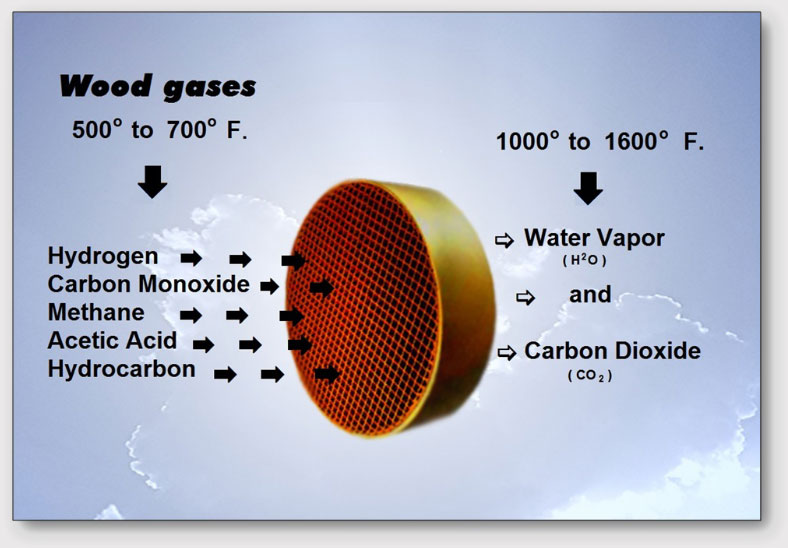
Benefits to Using a Catalytic Woodstove
Health
The health benefits associated with reducing PM 2.5 emissions, including wood smoke, are significant. Studies indicate that PM 2.5 poses a serious public health problem. Exposure to PM 2.5 can cause premature death and harmful effects on the cardiovascular system (the heart, blood, and blood vessels).
Particle pollution exposure is also linked to a variety of other public health problems, including respiratory diseases. People with diseases that affect the heart or lung (including asthma), older adults, children, and people living in lower socioeconomic conditions are at greatest risk from PM 2.5 exposure.
Research indicates that pregnant women, newborns, and people with certain health conditions, such as obesity or diabetes, may also be at increased risk.
EPA estimates that if all of the old wood stoves in the U.S. were replaced with cleaner-burning hearth appliances, an estimated $56-126 billion in health benefits per year would be realized.
For more information, go to: http://www.epa.gov/airquality/benmap/sabpt.html
-United States Environmental Protection Agency, “Reducing Residential Wood Smoke” March 2013

Financial
Lower Operating Costs for Woodstove Purchasers. Only half the amount of wood is necessary vs. a “dirty” woodstove. Potential purchasers should always look for the lower operating costs when selecting a new heating stove.

EPA Burn Wise
- 2015 NSPS
- 4.5 grams per hour for all wood burning appliances by 2015
- 2.0 grams per hour for all wood burning appliances by 2020
- What about toxic gases? A catalytic combustor will fully oxidize all of them at lower temperatures than secondary combustion stoves (non-catalytic) operate.

What is a Catalyst?
By definition, a catalyst is not consumed or used up. The nature of a catalytic reaction is often defined as: “a substance, usually present in small amounts related to the reactants, that modifies and especially increases the rate of a chemical reaction without being consumed in the process.”
How do they work?
Normally, smoke will burn or oxidize, at a temperature of 1000° F. or higher. Burning a stove this hot would require continuous intense fire and would require a higher wood consumption. The answer to eliminate this is the catalytic combustor.
Wood smoke gases coming in contact with the catalyst, causes chemical changes to take place. This will then allow the smoke to ignite at temperatures around 500° F. or (260° C.). This temperature is easily achieved in the fire-box of a woodburning stove. As the wood gases ignite and burn within the catalytic combustor, clean by-products of water vapor (H2O) and carbon dioxide (CO2) are emitted.

Why Combustors Need To Be Replaced?
Thermal Shock
Occurs when refueling with wood containing excess moisture either on it or in it. This is most common with green or un-aged wood. Moist smoke is sent to the combustor when the by-pass is closed and the results are thermal shock and cracking of the substrate. A continual practice of this will cause the combustor to deteriorate.
Fatigue
The catalytic combustor has a six-year life expectancy when used according to the stove owner’s manual. Although, some combustors have operated with efficiency for as high as ten years, the combustor’s life is based on the stove operator, maintenance, fuels used, and the stove manufacturer’s design.
Mishandling
Or abuse to the combustor. A few examples would be…dropping it, using abrasive tools for cleaning it, using high pressure air to blow the cell free of any fly-ash build-up, using cleaning solvents to clean it or perhaps beating on it to remove it from it’s holding device.
Direct Flame Impingement
Flames burning for long periods of time directly into the combustor with the by-pass or damper closed will cause this. Allowing this to happen will change the make up of the catalyst and reduce the efficiency as well.
Flame impingement on a continual basis will cause the substrate to break down. Some of the reasons flame impingement occurs are operating the stove with the firebox door ajar or the ash pan not closed tightly. Air leaking around the door can sometimes occur if proper maintenance in not conducted on the outer gaskets. Other reasons might be that the door gasket needs replaced or the air intakes are left wide open after the by-pass has been closed. Uncontrollable draw or fast draft can be controlled with use of a barometric damper.
Poisoning
This happens by burning materials other than seasoned dried wood. Foreign matter such as garbage, painted wood, large amounts of colored paper, cardboard, rubber, plastic, paneling with glue, oily products and so on will eventually reduce the efficiency of the catalyst.
